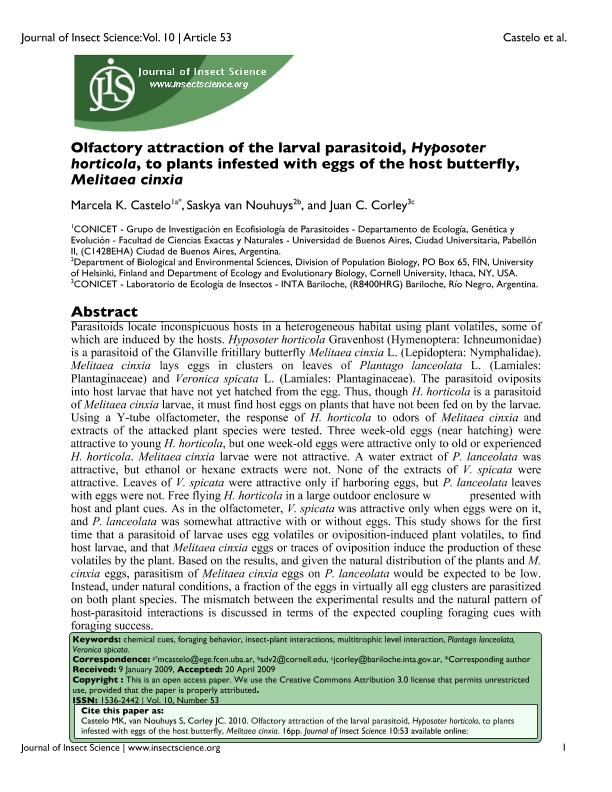Artículo
Olfactory Attraction of the Larval Parasitoid, Hyposoter horticola , to Plants Infested with Eggs of the Host Butterfly, Melitaea cinxia
Fecha de publicación:
06/2010
Editorial:
University of Arizona
Revista:
Journal of Insect Science
ISSN:
1536-2442
Idioma:
Inglés
Tipo de recurso:
Artículo publicado
Clasificación temática:
Resumen
Parasitoids locate inconspicuous hosts in a heterogeneous habitat using plant volatiles, some of which are induced by the hosts. Hyposoter horticola Gravenhost (Hymenoptera: Ichneumonidae) is a parasitoid of the Glanville fritillary butterfly Melitaea cinxia L. (Lepidoptera: Nymphalidae). Melitaea cinxia lays eggs in clusters on leaves of Plantago lanceolata L. (Lamiales: Plantaginaceae) and Veronica spicata L. (Lamiales: Plantaginaceae). The parasitoid oviposits into host larvae that have not yet hatched from the egg. Thus, though H. horticola is a parasitoid of Melitaea cinxia larvae, it must find host eggs on plants that have not been fed on by the larvae. Using a Y-tube olfactometer, the response of H. horticola to odors of Melitaea cinxia and extracts of the attacked plant species were tested. Three week-old eggs (near hatching) were attractive to young H. horticola, but one week-old eggs were attractive only to old or experienced H. horticola. Melitaea cinxia larvae were not attractive. A water extract of P. lanceolata was attractive, but ethanol or hexane extracts were not. None of the extracts of V. spicata were attractive. Leaves of V. spicata were attractive only if harboring eggs, but P. lanceolata leaves with eggs were not. Free flying H. horticola in a large outdoor enclosure were presented with host and plant cues. As in the olfactometer, V. spicata was attractive only when eggs were on it, and P. lanceolata was somewhat attractive with or without eggs. This study shows for the first time that a parasitoid of larvae uses egg volatiles or oviposition-induced plant volatiles, to find host larvae, and that Melitaea cinxia eggs or traces of oviposition induce the production of these volatiles by the plant. Based on the results, and given the natural distribution of the plants and M. cinxia eggs, parasitism of Melitaea cinxia eggs on P. lanceolata would be expected to be low. Instead, under natural conditions, a fraction of the eggs in virtually all egg clusters are parasitized on both plant species. The mismatch between the experimental results and the natural pattern of host-parasitoid interactions is discussed in terms of the expected coupling foraging cues with foraging success.
Archivos asociados
Licencia
Identificadores
Colecciones
Articulos(IEGEBA)
Articulos de INSTITUTO DE ECOLOGIA, GENETICA Y EVOLUCION DE BS. AS
Articulos de INSTITUTO DE ECOLOGIA, GENETICA Y EVOLUCION DE BS. AS
Citación
Castelo, Marcela Karina; Nouhuys, Saskya van; Corley, Juan Carlos; Olfactory Attraction of the Larval Parasitoid, Hyposoter horticola , to Plants Infested with Eggs of the Host Butterfly, Melitaea cinxia; University of Arizona; Journal of Insect Science; 10; 53; 6-2010; 1-16
Compartir
Altmétricas




